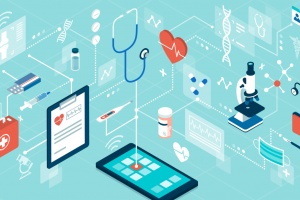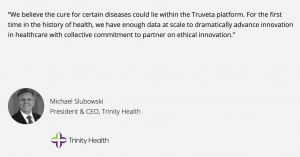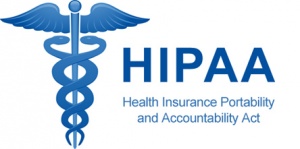Healthcare Data Monetization
Healthcare data monetization is the practice of utilizing data collected in healthcare settings for profit. [1] The monetization of healthcare data is a relatively new practice which has grown in popularity in part because of the rise of digital marketing. [2] Healthcare data is sensitive by nature and healthcare patients privacy are protected by various laws. [3] Because of the importance of patient privacy, healthcare data can be monetized directly and indirectly, but unlike other forms of data monetization, the data must be anonymous to comply with HIPAA laws. [4] Healthcare data privacy is a controversial issue and has raised questions as to if the data belongs to the healthcare provider or the patient.
Contents
Overview
The definition of monetize is “to change into money.” [5] It is common practice for companies and organizations to collect data on users and use that data as an additional revenue stream. This can make some people uncomfortable to know that the data being collected on them from social media or online shopping is being used to make a company money; as a result, some people choose to take measures to maintain anonymity including encryption, frequent email changes, and false names. [6] Banking and health records are being moved from paper to electronic mediums, and for most people, being part of the Big Data (with accurate and up to date information)for these things is unavoidable. Highly sensitive data requires increased care and privacy considerations, which results in companies paying large amounts of money to store and protect sensitive data, with the budget increasing every year.[7] The rise of health data monetization is leveraging the huge amount of healthcare data already available to store, protect, and increase revenue. [8]
History
History of Electronic Health Data
Health records were poorly kept up until about the 19th century; however, by the end of the 19th century, health records included diagnosis, family history, notes, instructions, clinical tests, and other forms of notes and data which is now considered commonplace today. [9] Because health records were taken by hand historically, different doctors or hospitals would only have the records that were accessible to them immediately and so records were often discontinuous from place to place. Paper records were still prominent into the mid to late 20th century; in about the 1970s and 1980s, software development made it possible for patient data to be inputted electronically, indexed, and accessed across all departments of a health system. [10] There has been a push for healthcare organizations to utilize Electronic Health Records (EHR), and as of 2017, about 86% of physicians have adopted EHR. [11]
The amount of new health data being generated every year with the amount of new data in 2020 globally being 2,314 exabytes, where 1 exabyte is equivalent to 1 billion gigabytes. [12] It is projected that for the United States, expenditures on EHR will total around $19.9 billion in 2024. [13]
History of Data Monetization
Companies have adopted data monetization strategies to increase revenue and lower costs. Data monetization rose in prominence with the rise of digital advertising; data on consumers was constantly being collected to pinpoint consumer behavior and personalize marketing. [14] Companies use data collected to help improve the experience of the consumer with the hopes that the provided services will continue to be utilized. Spotify is an example of a business-to-consumer enterprise which has adopted data monetization strategies. Spotify customizes playlists based on recent listening activity which uses data collected from the listener to improve the experience with the product. [15] This is an example of indirect monetization, which may make the listener less likely to use competitor streaming services or more likely to pay for Spotify Premium. A different method of data monetization is the direct selling of data to a third party, oftentimes without the knowledge of the user.
Methods to Monetize
Indirect
Indirect implies that the data monetization comes from leveraging the data to increase revenues, never leaving the organization. [8] By analyzing the data that is being collected on patients, more strategic, calculated decisions can be made. For health systems, this means that clinical data can be used to help innovate care delivery processes; additionally, patterns in demographic, health behaviors, and health data can used to improve health outcomes of patients. [16] Preventative care tends to be cheaper for health organization than a trip to the emergency room, and so if on the large scale, patient health outcomes are improved with the help of leveraging data, health systems can save money. [17]
Direct
Direct monetization implies the selling of data for a profit. [8] Buyers of this data are typically suppliers in a clinical setting or pharmaceutical companies who are interested in improving marketing strategies or assessing clinical need. [18] To comply with the various laws surrounding patient privacy, data that leaves an organization is made anonymous.
Current Examples of Health Data Monetization
Truveta, Inc.
Truveta is a startup made up of a pool of 14 of the largest health systems in the United States that can come together to pool their anonymous health data; the goal of Truveta is to “leverage patient data to improve patient care, address health inequity, accelerate the development of treatments and reduce the time to make a diagnosis.” [19] While this may seem indirect since no data is directly being sold, it is direct monetization in that the de-identified patient information is leaving the organization. This specific startup is cofounded by providers, with those health systems participating benefiting from the data analysis and information found. They claim that they will help advance healthcare by: improving patient care, accelerating treatment during pandemics, expediting the diagnostic odyssey, advance health equity, and empower patients on their journey. [20] This aligns with the mission of health systems to achieve better health, but also can save these health systems millions of dollars down the line.
VITAL Platform
VITAL is a platform created by Highmark Health with the goal of leveraging claims and clinical data to “generate evidence that can lead to reduced medical spend, improved quality outcomes and enhanced patient access to new technologies.” [21] Started in 2015, VITAL allowed Highmark to try out and analyze the effect of new technologies that saved money and improved health outcomes; at this point, this was indirect monetization, as it was within the organization. [21] However, since this time, VITAL has considered commercializing, which would be direct, since the data would be being sold outside the organization.
Ethical Considerations
HIPAA
HIPAA stands for the Health Insurance Portability and Accountability Act of 1996. It is a “federal law that required the creation of national standards to protect sensitive patient health information from being disclosed without the patient’s consent or knowledge.”[22] HIPAA is the primary set of laws to be considered by healthcare providers to avoid legal repercussions. It is legal to share protected health information (PHI), as long as confidentiality is maintained; oftentimes this means any identifying information is omitted. [22] It is this de-identifying that allows for health systems to monetize their data directly. One concern that has been brought up regarding this privacy that HIPAA affords with is that when given to a third party or merged and compared to other data sets, identification of patients may be easy.[23]
Data ownership
The default for a provider to record health data is to do so electronically as nearly all physicians have adopted EHR. Once a provider inputs health data from a visit, the patient may not truly know what is being done with the data. There is debate in the medical ethic community regarding the ownership of data and who is the owner of this data once input into an EHR system. [24] Some believe that because the data is about the patient, it belongs to that individual, while others believe their is a "co-ownership" of this data. [24] Specifically when it comes to data monetization, the ethics behind how reimbursement for any profit off of clinical data is up for discourse. [24]
Inclusion
Representation within data is also an ethical consideration. Health data has the power to make life saving changes, but it has been called into question if it will exclusively benefit those whose identities are most represented in the data. Therefore, there has been a rise in consideration of certain populations to increase representation within clinical settings. [25] Those who identify with the LGBTQ+ community, for example, often have poor experiences interacting with the healthcare system, and therefore may delay care or treatment; this means that on average, the data we have for this group is less comprehensive and will not benefit the same from leveraging health data. [26] Additionally, minority populations tend to interact with the healthcare system less due to previous unpleasant experiences or general mistrust of the medical community, and so the data for these groups cannot be representative and as powerful. [27]
References
- ↑ Foley & Lardner LLP. (2016). Tapping Into the Big Value of Health Care Big Data [White Paper]. https://www.foley.com/-/media/files/insights/publications/2015/02/tapping-into-the-big-value-of-health-care-big-data/files/tapping-into-the-big-value-of-health-care-big-data/fileattachment/monetization-of-data-white-paper.pdf
- ↑ Moreno, N. (2020, February 24). The rise of big tech monetising healthcare data. Retrieved March 25, 2021, from https://www.information-age.com/rise-big-tech-monetising-healthcare-data-123487860/
- ↑ Department of Labor and Department of, & U.S. Department of Health and Human Services (HHS)& Department of Labor& Department of Treasury(n.d.). HIPPA: Impacts and actions by states. Retrieved March 25, 2021, from https://www.ncsl.org/research/health/hipaa-a-state-related-overview.aspx
- ↑ Bresnick, J. (2019, December 18). The difference between big data and smart data in healthcare. Retrieved March 25, 2021, from https://healthitanalytics.com/features/the-difference-between-big-data-and-smart-data-in-healthcare
- ↑ Monetize. (n.d.). Retrieved March 25, 2021, from https://dictionary.cambridge.org/us/dictionary/english/monetize
- ↑ Madden, M., & Rainie, L. (2019, December 31). Attempts to obscure data collection and preserve anonymity. Retrieved March 25, 2021, from https://www.pewresearch.org/internet/2015/05/20/attempts-to-obscure-data-collection-and-preserve-anonymity/
- ↑ Garrity, M. (n.d.). 5% of hospital IT budgets go to cybersecurity despite 82% of hospitals reporting breaches. Retrieved March 25, 2021, from https://www.beckershospitalreview.com/cybersecurity/5-of-hospital-it-budgets-go-to-cybersecurity-despite-82-of-hospitals-reporting-breaches.html
- ↑ 8.0 8.1 8.2 Crabb, S. (n.d.). A new era in healthcare data monetization. Retrieved March 25, 2021, from https://www.hfma.org/topics/blog/63157.html#:~:text=Simply%20stated%2C%20data%20monetization%20is,most%20relevant%20topics%20in%20healthcare
- ↑ Gillum, R. F. (2013). From papyrus to the electronic tablet: a brief history of the clinical medical record with lessons for the digital age. The American journal of medicine, 126(10), 853-857.
- ↑ Brooks, A. (2015, March 23). Health information management history: Past, present & future. Retrieved March 25, 2021, from https://www.rasmussen.edu/degrees/health-sciences/blog/health-information-management-history/
- ↑ Office-based physician electronic health record adoption. (n.d.). Retrieved March 25, 2021, from https://dashboard.healthit.gov/quickstats/pages/physician-ehr-adoption-trends.php#:~:text=Summary%3A,from%2042%25%20to%2086%25
- ↑ Statista. (2020, September 24). Projected growth in global healthcare data volume 2020. https://www.statista.com/statistics/1037970/global-healthcare-data-volume/#:%7E:text=However%2C%20projections%20indicate%20that%20there,new%20data%20generated%20in%202020
- ↑ Jercich, K. (2020, May 21). Hospital EHR spending projected to reach $9.9B by 2024. Healthcare IT News. https://www.healthcareitnews.com/news/hospital-ehr-spending-projected-reach-99b-2024
- ↑ Kurzer, R. (2018, August 15). The story of data: How did we get here? MarTech Today. https://martechtoday.com/the-story-of-data-how-did-we-get-here-215146
- ↑ How Your Daily Mix “Just Gets You.” (2018, November 28). Spotify. https://newsroom.spotify.com/2018-05-18/how-your-daily-mix-just-gets-you/
- ↑ Miliard, M. (2021, February 12). Truveta, formed with big-name health systems, aims for AI-powered. Healthcare IT News. https://www.healthcareitnews.com/news/truveta-formed-big-name-health-systems-aims-ai-powered-data-advances
- ↑ Musich, S., Wang, S., Hawkins, K., & Klemes, A. (2016). The Impact of Personalized Preventive Care on Health Care Quality, Utilization, and Expenditures. Population health management, 19(6), 389–397. https://doi.org/10.1089/pop.2015.0171
- ↑ Arndt, R. Z. (2018, April 7). How third parties harvest health data from providers, payers and pharmacies. Modern Healthcare. https://www.modernhealthcare.com/article/20180407/NEWS/180409938/how-third-parties-harvest-health-data-from-providers-payers-and-pharmacies
- ↑ Shah, A., & Patel, N. (2021, March 5). Contributed: Unlocking value in health data: Truveta’s data. MobiHealthNews. https://www.mobihealthnews.com/news/contributed-unlocking-value-health-data-truveta-s-data-monetization-strategy-carries-big-risks
- ↑ Truveta. (2021). Why Truveta. https://truveta.com/why-truveta
- ↑ 21.0 21.1 VITAL. (n.d.). Our Vision for Transformation. Retrieved March 25, 2021, from https://vitalinnovation.com/about-us
- ↑ 22.0 22.1 CDC. (n.d.). Health Insurance Portability and Accountability Act of 1996 (HIPAA) | CDC. Retrieved March 25, 2021, from https://www.cdc.gov/phlp/publications/topic/hipaa.html
- ↑ RE, D. N. G., & Leavy, M. B. (2014). Registries for Evaluating Patient Outcomes: A User's Guide. Agency for Healthcare Research and Quality (US).
- ↑ 24.0 24.1 24.2 Ballantyne, A. (2020). How should we think about clinical data ownership?. Journal of medical ethics, 46(5), 289-294.
- ↑ Dencik, L., Hintz, A., Redden, J., & Treré, E. (2019). Exploring data justice: Conceptions, applications and directions.
- ↑ Cigna. (2017, February). LGBT Health Disparities | Cigna. https://www.cigna.com/individuals-families/health-wellness/lgbt-disparities
- ↑ DeAngelis, T. (2019, March). How does implicit bias by physicians affect patients' health care? Monitor on Psychology, 50(3). http://www.apa.org/monitor/2019/03/ce-corner


